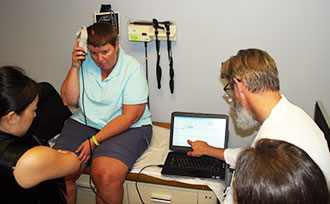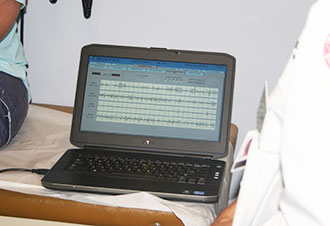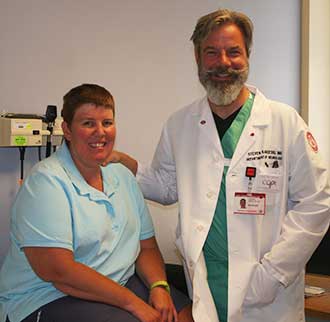
Tracey Drake, the first epilepsy patient at NewYork-Presbyterian/Weill Cornell Medical Center to have a newly approved intracranial device implanted, recently had the implant programmed to start generating the stimulation impulses designed to reduce seizures.
The device, the RNS® System from NeuroPace, was surgically placed by Dr. Theodore Schwartz and the epilepsy team last month. (See earlier news article.) During the first few weeks after the surgery, the device recorded Tracey’s brain activity during seizures to start to identify patterns that predict the onset of a seizure.
“Each individual’s seizures have a distinct fingerprint,” says Tracey’s neurologist, Steven Karceski, M.D. “The first job of the implanted device is to identify that fingerprint as precisely as possible, and to detect certain patterns that will allow us to predict when a seizure is about to begin. Once we know that, we can program the device to recognize those patterns and respond by delivering a small electrical impulse to the area of the brain where the seizures begin. The stimulation interrupts that abnormal brain activity and prevents the seizure from occurring.”
 Tracey’s brain activity is stored in the Patient Data Management System, where Dr. Karceski can monitor it from afar. Here, brain waves are shown in real time as Tracey holds the wand to the implanted device.
Tracey’s brain activity is stored in the Patient Data Management System, where Dr. Karceski can monitor it from afar. Here, brain waves are shown in real time as Tracey holds the wand to the implanted device.Dr. Karceski has been remotely monitoring Tracey’s brain activity during the weeks since the implant surgery. Every time she felt a seizure starting, Tracey would hold a special magnet to her head over the implant site to capture her brain activity at that moment. Later, the implant downloaded information about her brain activity through the wand to a laptop, which then transmitted the data to the online Patient Data Management System (PDMS), where Dr. Karceski could review it.
At Tracey’s latest visit, Dr. Karceski was able to report that the data in the PDMS revealed two distinct patterns in her brain activity that indicated a seizure about to begin. Based on that information Dr. Karceski programmed the device to start delivering a very gentle pulse to the brain when those patterns are detected.
“I don’t really feel anything,” said Tracey during a test of the pulse, which is set to an extremely low level for this initial phase of stimulation. That’s good news. Ideally the entire process will happen without Tracey feeling anything at all as the stimulator recognizes the pattern, delivers the pulse, and prevents the seizure. That is exactly the goal: To return Tracey to a normal life, with the implant preventing the disabling seizures that have plagued her for nearly 15 years.
For the next month, the implanted device will be both delivering stimulation and continuing to record data about brain activity before and during seizures.
 Tracey Drake with Dr. Steven Karceski, the neurologist managing her care.
Tracey Drake with Dr. Steven Karceski, the neurologist managing her care. “One of the issues Tracey’s been having is that her seizures are so frequent, and they range from just a few seconds to five minutes or longer,” says Dr. Karceski. “That makes it hard to see what her normal brain waves look like, to compare with a seizure’s fingerprint.” During this next stage of the process, Tracey will periodically use the wand to download data at times when she feels good, with no evidence of seizure activity, to provide a better baseline for comparison to those times when a seizure is in progress. The implant will become “smarter” over time as it collects additional data about normal activity versus activity that predicts a seizure’s onset. The intensity of the pulse can be adjusted over time to match the level of stimulation required to interrupt the seizure.
Tracey will return in a month for her next follow-up visit, at which Dr. Karceski can adjust the implant based on data collected during that time. In the meantime Tracey and her family are off on a summer vacation, during which she’ll continue to use the wand and laptop to send her brain waves back to Dr. Karceski and the PDMS. She’ll also be carrying an identification card to confirm to airport security that she has an implanted medical device, to avoid travel delays.
More about the Weill Cornell Epilepsy Program